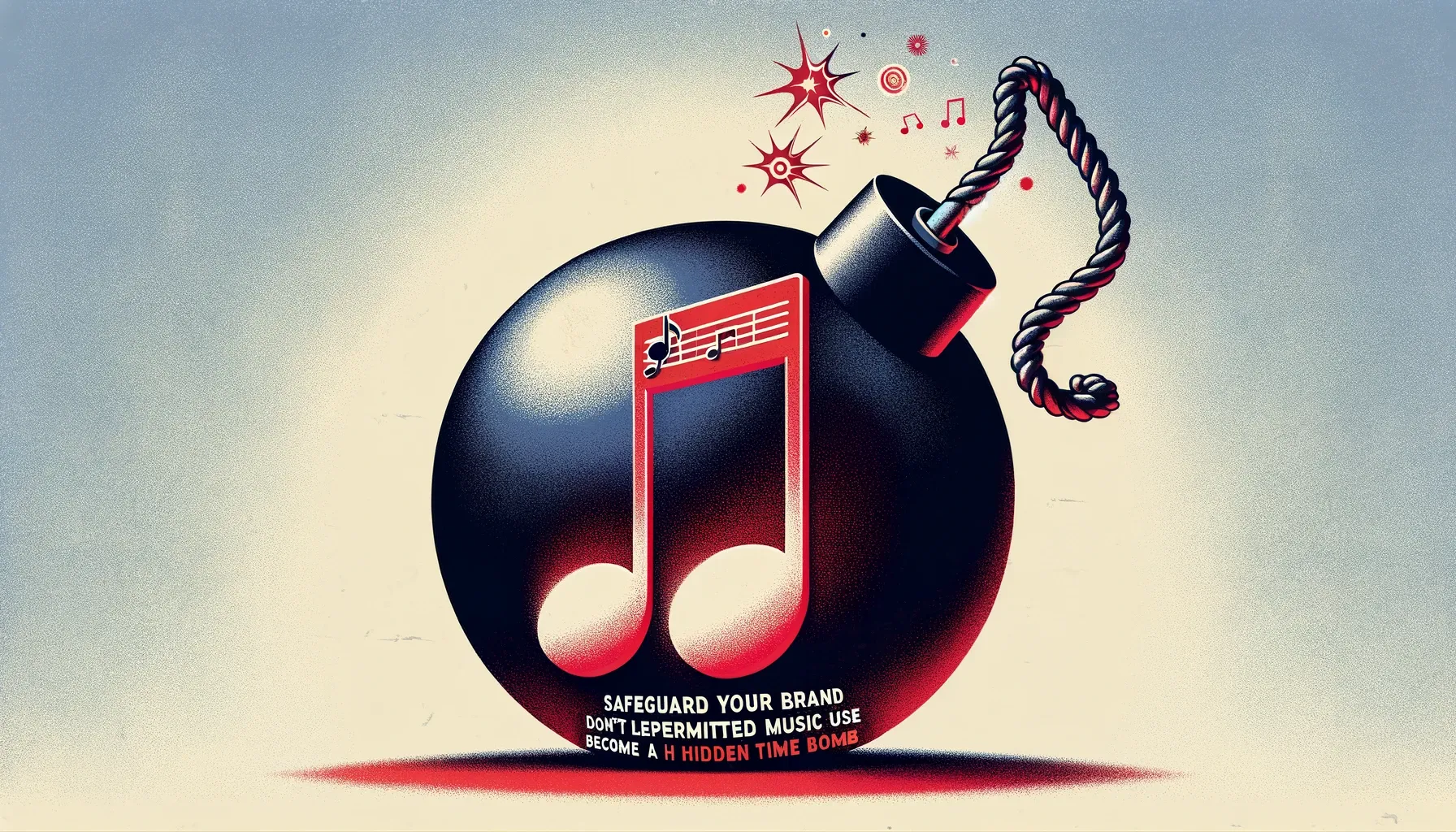Safeguard Your Brand in 2024: Use Copyrighted Music and CapCut Safely
As more brands are doubling down on their organic content on social media, there is a rising risk of using unpermitted music. Learn the potential risk with inadvertent use of commercial music and what brands should do in 2024.
About the Author
American entrepreneur, co-founder and Co-CEO of Slip.stream. He is the former co-founder and COO of Jingle Punks Music. He has been featured in Billboard, Variety, and Business Week
A lot of brands are playing with fire and they don’t know it.
The brands are planting a ticking time bomb with each social post they make.
Today, let's explore one essential step to protect your brand in 2024:
Only use music that you are permitted to in your branded content.
Many TikTok videos and blog posts highlight the limitation of "no access to trending sound" as a “con” in the debate of personal versus business accounts on TikTok. Indeed, not leveraging trending sounds can mean missing out on vital aspects of TikTok culture, resulting in less engagement with content that uses the less appealing commercial music library. However, an important point often overlooked is
As a brand, you should not use trending sounds in the first place.
Thus, this isn't merely a matter of weighing "pros vs cons," but rather, it involves significant legal considerations. If you don't have the time to read the Terms of Service of TikTok personal account, here let’s decipher for you what is written
NO RIGHTS ARE LICENSED WITH RESPECT TO SOUND RECORDINGS AND THE MUSICAL WORKS EMBODIED THEREIN THAT ARE MADE AVAILABLE FROM OR THROUGH THE SERVICE.
To put it simply, while TikTok provides easy access to a wide array of sounds including the ones that other users upload, it explicitly states that no rights or licenses are conferred with their use. However, for brands, using music in branded content is a commercial endeavor, which necessitates appropriate licensing.
TikTok gets its a*** covered in the T&C while leaving brands using music for branded content vulnerable.
What are the trending sounds on TikTok?
99.9% of the trending sounds on TikTok are commercial music. Commercial music refers to music that is created, produced, and distributed for profit, usually owned by labels. Enjoying commercial music through authorized distribution channels, like radio, TV, Spotify, Apple Music, to name a few, is 100% legal.
Using commercial music in a different context, like in advertising or other branded content, involves licensing agreements. Brands often pay royalties or purchase broadcast licenses to use specific music in their commercials or broadcasts. For instance, Metallica's song "Last Caress" was used in an Amazon Echo commercial:
Similarly, when brands incorporate music into their content on TikTok, they are also subject to licensing requirements. The ease of adding music on TikTok doesn't exempt brands from the legal requirements associated with using commercial music. Just because the process is straightforward doesn't mean it bypasses the need for proper licensing.
Music labels have a track record of suing brands for unpermitted use of music
Instances like Sony suing Gymshark in July 2021 over the use of copyrighted music in social media videos, demanding $150,000 per track for damages, and Warner Music Group's lawsuit against Bang Energy in 2022 for using music from artists like Cardi B without a license, are stark reminders of the risks involved.
Many of us are old enough to recall the Napster case, where music labels sued individuals for illegally downloading music. Music labels never stop - they always look for copyright infringements and unpermitted music use. Post-COVID, there's been a noticeable shift in focus from traditional channels to digital publishing platforms and digital content.
How to use copyrighted music safely?
The safest route for using copyrighted music is to obtain a license or direct permission from the copyright holder, regardless of the length of the music utilized in the content. This often involves a fee or agreement on how the music can be used.
Is CapCut music copyrighted free?
In short, yes. Music on Capcut is copyrighted. Here is what is written in CapCut's Terms & Conditions:
Intellectual Property Rights: The Services, including music, are protected under copyright laws. All intellectual property rights in the Services are owned by CapCut or its licensors. Users are required not to infringe on any intellectual property rights, including copyright laws, when using the Services (Sections 11 and 12).
That said, music provided by CapCut is copyrighted, and should be handled the same way as copyrighted music in general.
CapCut is a great tool for social media managers handling social content on the fly, for all channels, not just TikTok. While it is generally safe for individuals to use the music provided by Capcut on TikTok personal accounts with non-promotional/commercial-oriented content, brands or promotional content should use the CapCut music with caution.
Consequently, if content creators create content using music provided by CapCut, when they upload the same content to other platforms, especially YouTube, the music could already registered with Content-ID, resulting in the content being claimed by YouTube and thus not eligible for monetization.
What should the brands do in 2024?
As mentioned above, platforms like TikTok or Instagram have made it easy from a UI/UX perspective to use any music in video content, which aligns with their best interest, that is to drive output of content on the platform to remain competitive and continuously drive traffic. Brands need to be extra careful while enjoying such convenience.
Don't use music from unknown sources.
When encountering an Instagram reel from a brand featuring background music labeled as “Original sound,” it's likely that the brand has obtained the rights to use that music. This could be through purchasing a license or subscribing to a royalty-free music service like Slip.stream, Epidemic Sounds, or Artlist. Music is added and then the video is uploaded as a whole to Instagram. Such original music should not be used because you don’t know the source and the use of it is definitely unpermitted.

Brands should only use TikTok music on their TikTok from TikTok commercial music library.
The biggest difference between TikTok personal and TikTok business is the applicable music library. Remember, using music from the commercial library is never just a “con”, it is a must.
Don’t assume the music provided by one platform can be used somewhere else.
For instance, CapCut typically licenses music for use exclusively on TikTok. Using CapCut's music library for content intended for other platforms could lead to unauthorized use. If you use CapCut to create a YouTube video, the video is likely to be claimed.
Similarly, the YouTube Audio Library offers music for content creation, but the rights are often limited to YouTube.
Check the music used by your TikTok brand ambassadors and influencers.
While these individuals often operate TikTok personal accounts with access to a broader range of commercial music, complications arise when they create content in partnership with brands. In such cases, it's essential to ensure that the music used is properly licensed for commercial use by all involved parties.
With the rising costs of paid media, many brands are shifting towards a more organic approach in their content strategies. This shift often involves leveraging user-generated content (UGC) and creating UGC-styled branded content. This strategy not only showcases the product's functionality but also builds a more natural and authentic connection with the consumers. Such approaches have been successful for numerous brands, including the above-mentioned brands Gymmshark and Bang Energy, that have gotten into copyright infringement troubles.
If your content marketing strategy doesn’t take off or generates few views, you can hide the videos with unpermitted music use with little damage. However, if it does go viral, you have to archive your entire marketing success because the music labels will track down the use like sharks smelling blood in the water.
Check out great and trendy music 100% safe to use on all social platforms from Slip.stream.
